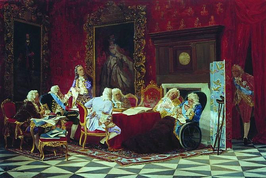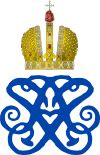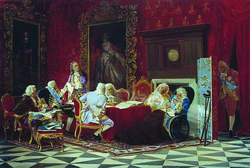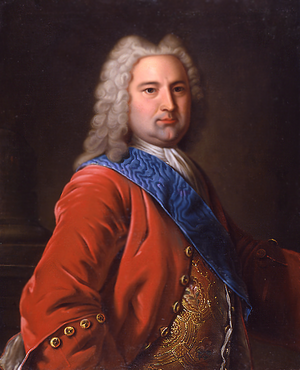آنا من روسيا
| Anna | |
|---|---|
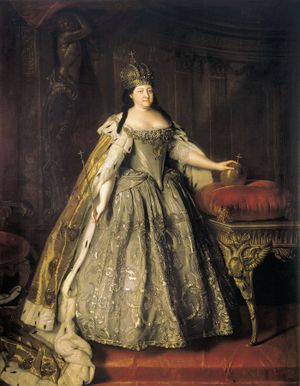 | |
| Empress and Autocrat of All the Russias | |
| العهد | 30 January 1730 - 28 October 1740 (10 years, 272 days) |
| التتويج | 28 April 1730 |
| سبقه | Peter II |
| تبعه | Ivan VI |
| وُلِد | 7 فبراير 1693 Moscow |
| توفي | 28 أكتوبر 1740 (aged 47) |
| الزوج | Frederick Wilhelm, Duke of Courland |
| البيت | House of Romanov |
| الأب | Ivan V of Russia |
| الأم | Praskovia Saltykova |
آنا إيڤانوڤنا (روسية: Анна Ивановна؛ Anna Ivanovna؛ 7 فبراير [ن.ق. 28 يناير] 1693، موسكو – 28 أكتوبر [ن.ق. 17 أكتوبر] 1740) ابنة إيڤان الكسيفيتش البالغة خمسة وثلاثين عاماً، وأبوها كان الأخ الأبله لبطرس الأكبر. وقد اختارها المجلس الأعلى لأنها اكتسبت سمعة واقية بالوداعة والطاعة. ووضع المجلس الذي كان يهيمن عليه آل دولجوروكي وجولتسين "شروطاً" بعثوا بها إلى آنا وهي في كورلاند، لا بد من قبولها لتثبيتها على العرش. فوقعت على الشروط (28 يناير 1730). ولكن لا الجيش ولا الاكليروس أرادوا إحلال الاولجركية محل الأوتقراطية. لذلك انطلق وفد من حرس القصر للقاء آنا، والتمس منها أن تتقلد زمام السلطة المطلقة. فاستوحث الشجاعة من أسلحتهم، ومزقت "الشروط" على مرأى من الحاشية.
النشأة
Anna was born in Moscow as the daughter of Tsar Ivan V by his wife Praskovia Saltykova. Ivan V was co-ruler of Russia along with his younger half-brother Peter the Great, but he was mentally disabled and incapable of administering the country, and Peter effectively ruled alone. Ivan V died in February 1696, when Anna was only three years old, and her half-uncle became the sole ruler of Russia.[بحاجة لمصدر]
Although Anna was the fourth child of her parents, she had only one surviving elder sister, Catherine, and one younger sister, Praskovia. The three girls were raised in a disciplined and austere manner by their widowed mother, a stern lady of sterling character. Born into a family of relatively modest means, Praskovia Saltykova had been an exemplary wife to a mentally challenged man, and expected her daughters to live up to her own high standards of morality and virtue.[2] Anna grew up within a milieu which cherished womanly virtue and domesticity above all else, and placed strong emphasis on thrift, charity and religious observances.[3] Her education consisted of French, German, religious texts and folklore, leavened with some music and dancing.[4] As she grew older, she developed into an obstinate girl, with a mean streak, earning her the nickname "Iv-anna the Terrible".[5] Anna was famed for her big cheek,[مطلوب توضيح] "which, as shown in her portraits", says Thomas Carlyle, "was comparable to a Westphalian ham".[بحاجة لمصدر]
In time, her uncle Peter the Great ordered the family to move from Moscow to St. Petersburg. This meant a change of not just location but also society, and this had a significant effect on Anna. She greatly enjoyed the splendour of court and the lavishness of high society, which was very different from the austerity preferred by her mother.[4]
الوصاية على كورلاند
In 1710, Peter the Great arranged for the 17-year-old Anna to marry Frederick William, Duke of Courland, who was about the same age as her.[6] Her wedding was held on a grand scale, as per her own inclinations, on 11 November 1710; and her uncle gave her a fabulous dowry of 200,000 roubles.[6] At the feast which followed the wedding, two dwarfs performed a parody by jumping out of enormous pies and dancing on the tables.[7]
The newly wedded couple spent several weeks in Russia before proceeding to Courland. Only twenty miles out of St. Petersburg, on the road to Courland, on 21 January 1711, Duke Frederick died. The cause of death was uncertain - it has been attributed variously to a chill or to the effects of alcohol.[7]
After her husband died, Anna proceeded to Mitau (now known as Jelgava), the capital of Courland (now western Latvia) and ruled that province for almost twenty years, from 1711 to 1730. During this period, the Russian resident, Count Peter Bestuzhev, was her adviser (and sometimes lover). She never remarried after the death of her husband, but her enemies said she conducted a love affair with Duke Ernst Johann von Biron, a prominent courtier, for many years.[بحاجة لمصدر]
ارتقاؤها العرش
وكانت آنا عديمة الثقة بالنبلاء الروس، فاستقدمت من كورلاند الألمان الذين كانوا يمتعونها هناك. فأصبح إرنست فون بورن، أو بيرون عشيقها السابق رئيساً للحكومة، ورد أوسترمان لرياسة الشئون الخارجية، وأعاد الكونت خريستوف فون مونيش تنظيم الجيش، وساعد لوفنفولدي وكورف، وكيزرلنج، على تطعيم نظام الحكم الجديد ببعض الكفاية الألمانية. فجمعت الضرائب بصرامة يقظة، ووسع التعليم وأدخلت عليه التحسينات، وهيئ للدولة جهاز مدرب من الموظفين المدنيين. وبمثل هذه الفاعلية سجنت الحكومة أو نفت أو أعدمت الدولجوروكيين والجولتسينيين.
وعاشت آنا عيشة منتظمة نسبياً، بعد أن قنعت بعشيقين (بيرون ولوفنفولدي)، فكانت تستيقظ في الثامنة، وتخص ثلاث ساعات لشئون الحكم، وتبتسم ابتسامة الرضى، إذ يبسط رجالها الألمان سلطان روسيا. فغزا جيش يقوده مونيش بولنده، وخلع ملكها ستانسلاس لسكزنسكي-الخاضع لتوجيه الفرنسيين-وأجلس على عرشه أوغسطس الثالث السكسوني، واتخذ أول خطوة على طريق ربط بولنده بالروسيا. وردت فرنسا بأن حرضت تركيا على أن تهاجم روسيا، ولكن السلطان تردد لانشغاله على جبهته الفارسية، فرأت روسيا الفرصة مواتية لإعلان الحرب على تركيا، وهكذا بدأت (1735) ستون سنة من صراع السيادة على البحر الأسود. وشرح دبلوماسيو آنا الموقف فقالوا إن الأتراك، أو من يلوذ بهم في جنوبي روسيا، في يدهم مخارج الأنهار الخمسة الكبرى-دنيستر، وبوج، ودنيير، ودون، وكوبان-التي كانت أهم مسالك التجارة الروسية المتجهة جنوباً، وأن القبائل الإسلامية نصف الهمجية التي سكنت الأحواض الدنيا لهذه الأنهار هي خطر دائم يتهدد مسيحيي روسيا، وأن الشواطئ الشمالية للبحر الأسود جزء طبيعي وضروري من روسيا، وأن شعباً عظيماً نامياً كالشعب الروسي يجب ألا يحال بعد اليوم بينه وبين الوصول إلى البحر الأسود والبحر المتوسط دون معوق، وقد ظلت هذه الحجج الأنشودة المتكررة التي ظلت تتغنى بها روسيا طوال ما بقي من القرن وما بعده.
سياسات حكمها
أما أول الأهداف فكان القرم، شبه الجزيرة الذي يقوم معقلاً تركياً على الجبهة الشمالية للبحر الأسود. وكان الاستيلاء على شبه الجزيرة تلك هو الغاية التي استهدفتها حملة مونيش عام 1736. وكان أعدى أعدائه في هذه الحملة المسافات المترامية والمرض... ذلك أنه كان عليه أن يعبر 330 ميلاً من القفار والبراري التي لا تستطيع لبلدة واحدة من بلادها أن تقدم الطعام أو الدواء لجيش عدته 57.000 مقاتل، وكان لزاماً أن ترافقهم ثمانون ألف عربة في طابور طويل معرض في أي نقطة أو لحظة لهجوم قبائل التتار عليه. واستطاع مونيش بفضل قيادته الماهرة أن يستولي في تسعة وعشرين يوماً على بريكوب، وكوسلوف، وبخشيسراي (عاصمة القرم)، ولكن في ذلك الشهر تفشت الدوسنطاريا وغيرها من الأمراض في جيشه فأحدثت من الشقاء والتمرد بين رجاله ما أكرهه على التخلي عن فتوحه والتقهقر إلى أوكرانيا، واستولى أثناء ذلك قائد آخر من قواد آنا على آزوف المشرفة على مصب نهر دون.
وكر مونيش على الجنوب في أبريل 1737 بسبعين ألف مقاتل، واستولى على اوخاكوف، قرب مصب نهر بوج. وفي يونيو انضمت إليه النمسا في مهاجمة الترك، ولكن حملتها باءت بفشل ذريع ألجأها إلى إبرام صلح منفرد، أما روسيا التي تركت فجأة لتواجه الجيش التركي برمته، والتي كانت تتوقع حرباً مع السويد، فقد وقعت (18 سبتمبر 1739) صلحاً رد إلى الأتراك تقريباً كل ما كسبه الروس في حملات ثلاث. واحتفل بالمعاهدة في سانت بطرسبرج على أنها انتصار باهر لم يكلف أكثر من مائة ألف قتيل.
وعاش آنا بعد سنة الحرب، وقبيل موتها عينت وريثاً للعرش، إيفان السادس، الغلام الذي لم يتجاوز عمره ثمانية أسابيع: وهو ابن بنت أختها آنا ليوبيو لدوفنا الألمانية المولد وأنطون أولريش أمير برنزويك. وأوصت أن يكون بيرون وصياً على إيفان حتى يبلغ السابعة عشرة. ولكن مونيش وأوسترمان كانا الآن قد نالهما من بيرون ما يكفي، فانضما إلى أولريش وليوبولدوفنا ونفوه إلى سيبيريا (9 نوفمبر 1740). وأصبحت آنا ليوبولدوفنا وصية، ومونيش "الوزير الأول". وخشي السفيران الفرنسي والسويدي أن يسيطر التيوتون على روسيا سيطرة كاملة، فمولا ثورة يقومبها الأشراف الروس. واختار الثوار سراً مرشحاً للعرش في اليزافيتا بتروفنا ابنة بطرس الأكبر وكاترين الأولى.
إمبراطورة روسيا
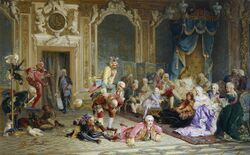
Anna continued to lavish architectural advances in St. Petersburg.[8] She completed a waterway that began construction under Peter the Great and called for seafaring ships to accompany this new canal and continue naval expansion.[9] Anna's lover Ernst Johann von Biron was a Baltic German and due to his influence Baltic Germans were favored with government offices, leading to the resentment of the ethnic Russian nobility, though the American historian Walter Moss cautioned that the popular image of the Bironovschina as one of total Baltic German domination of Russia is exaggerated.[10]
Cadet Corps
Anna founded the Cadet Corps in 1731, one year after coming to the throne. The Cadet Corps was a group of young boys starting at the age of eight being trained for the military. It incorporated a very rigorous training program which included all the schooling necessary for someone to hold an important position in the military. As time went on, the program was improved upon by other emperors and empresses, such as Catherine the Great. These began to include the arts and sciences into cadets' schooling, alongside established studies of military topics.[بحاجة لمصدر]
Academy of Science
Anna continued to fund the Russian Academy of Science, started by Peter the Great.[11] This school was designed to further the sciences in Russia, in order to help the country reach the level of the Western countries of that period. Some of the subjects taught were mathematics, astronomy, and botany. The Academy of Science was also responsible for many expeditions; a notable example was the Bering Sea Expedition.[11] While attempting to determine if America and Asia had been at one point connected, Siberia and its people was also studied. These studies were referenced long after the expedition returned from Siberia.[11] The Academy suffered interference from outside parties. Frequently the government and the church would meddle with funding and experimentation, altering data to match their respective points of view.[11] This school of science was very small, never exceeding a population of twelve students in the university and barely over a hundred in the secondary school. Still, it was a huge step forward for education in Russia. Many of the teachers and professors were imported from Germany, bringing a Western viewpoint to instruction students received. Some of the students taught by these German professors later became advisors or teachers to future leaders, such as Catherine the Great's tutor, Adodurov.[12] During Anna's reign the Academy of Science began to include the Arts into the program, as there was no school for the arts yet, and the Empress was a firm supporter of the arts. Theatre, architecture, engraving, and journalism were all added to the curriculum.[13] It was during this time the foundation of what is now the world-famous Russian Ballet were laid down.[14]
The Secret Office of Investigation
Anna resurrected the Secret Office of Investigation, whose purpose was to punish those convicted of political crimes, although some cases were occasionally taken that were not of a political nature.[15] It has been rumored since Anna's reign that Biron was the power behind the Secret Office of Investigation when in fact it was run by the senator A. I. Ushakov. The punishments meted out for the convicted were often very painful and disgusting. For example, some people that had supposedly been plotting against the government had their noses slit in addition to being beaten with the knout.[16] Russian authorities listed a total of around 20,000 Russians—including some of the highest native nobility—who fell victim to Biron and Anna's police.[17]
Nobility
Anna gave many privileges to the nobility. In 1730 she ensured the repeal of Peter the Great's primogeniture law prohibiting the division of estates among heirs. Starting in 1731 landlords were made responsible for their serfs' taxes, which had the effect of tightening their economic bondage further. In 1736, the age for a noble to begin his compulsory service to the state changed to 20 with a 25-year service time. Anna and her government also determined that if a family had more than one son, one could now stay behind to run the family estate.[18]
Westernization
Westernization continued after Peter the Great's reign in areas of prominent Western culture such as the Academy of Science, cadet corps education, and imperial culture including theater and opera.[19] Although not at the fast-paced speed of Westernization under her Uncle Peter's reign, it is evident that a culture of the expansion of knowledge continued during Anna's rule and affected mostly the nobility. It is argued that this success in Westernization is due to the efforts of the German court nobility; the foreigners' impacts are viewed both positively and negatively.[20]
Anna's reign was different from that of other imperial Russian rulers in one respect: her court was almost entirely made up of foreigners, the majority of whom were German. Some observers have argued that historians isolate her rule from Russian history due to their long-term prejudice towards Germans, towards whom Anna seems to have been sympathetic.[21]
There is a lot of mention of Germans throughout the reign of Anna. For example, she often gave them ruling positions in her cabinet and other important decision making positions. This was because she had very little trust in the Russians. It was because of this strong German influence in government that many Russians came to resent them.[14]
Foreign affairs
During Anna's reign Russia became involved in two major conflicts, the War of the Polish Succession (1733–1735) and another Turkish war.[22] In the former, Russia worked with Austria to support Augustus II's son Augustus against the candidacy of Stanisław Leszczyński who was dependent on the French and amiable with Sweden and the Ottomans. Russia's involvement with the conflict was quickly over, however, and the Russo-Turkish War (1735–1739) was much more important.[23]
In 1732 Nader Shah had forced Russia to return the lands in northern mainland Persia that had been taken during Peter the Great's Russo-Persian War; the Treaty of Resht furthermore permitted an alliance against the Ottoman Empire,[24] the common enemy and, in any case, the provinces of Shirvan, Ghilan, and Mazanderan had been a net drain on the imperial treasury for the entirety of their occupation.[17] Three years later, in 1735, conforming to the Treaty of Ganja, the remainder of the territories taken more than a decade earlier from Persia in the North Caucasus and South Caucasus were returned as well.[بحاجة لمصدر]
The war against the Turks took four and a half years, a hundred thousand men, and millions of rubles;[25] its burdens caused great stress on the people of Russia,[26] and it only gained Russia the city of Azov and its environs.[25] Its effects, however, were greater than they first appeared. Osterman's policy of southern expansion prevailed over the 1711 Peace of Pruth signed by Peter the Great.[27] Münnich had given Russia its first campaign against Turkey that had not ended in crushing disaster and dissipated the illusion of Ottoman invincibility. He had further shown that Russia's grenadiers and hussars could defeat twice their number of janissaries and spahis. The Tatar hordes of the Crimea had been exterminated and Russia's signal and unexpected successes greatly increased its prestige within Europe.[25][ب]
The Russians also established a protectorate over the khan of the Kirghiz, sending officers to assist his short-lived conquest of Khiva.[17]
Two Chinese embassies to Anna's court, first at Moscow in 1731, then at St Petersburg the following year, were the only ones China dispatched to Europe through the 18th century.[17][28] These embassies were unique also in that they represented the only occasions where officials of the Chinese Empire kowtowed before a foreign ruler.[29]
Relationship with Biron
After being widowed just weeks following her wedding, Anna never remarried. As empress of Russia, she enjoyed the power she held over all men and may have thought that marriage would undermine her power and position. Nevertheless, Anna's reign is often referred to as "The Age of Biron" (Bironovschina), after her German lover Ernst Johann Biron.[21] Historians concur that Biron not only had a strong influence on Anna's domestic and foreign policies, but also that at times he wielded power solely without reference to the Empress. Anna was attracted to Biron's personal charm and he proved to be a good companion to her, but his name became synonymous with cruelty and terror. In public perception these negative qualities became the hallmark of Anna's reign.[30]
الوفاة والخلافة
As her health declined Anna declared her grandnephew, Ivan VI, as her successor and appointed Biron as regent. This was an attempt to secure the line of her father, Ivan V, and exclude the descendants of Peter the Great from inheriting the throne.[25] It was recorded that she had an ulcer on her kidneys,[31] and she continued having attacks of gout; as her condition worsened, her health began to fail.[بحاجة لمصدر]
Anna died on 17 October 1740 at the age of 47 from a kidney stone that made for a slow and painful death.[32] The tsaritsa's final words focused on Biron.[33] Ivan VI was only a two-month-old baby at the time, and his mother, Anna Leopoldovna, was detested for her German counsellors and relations. As a consequence, shortly after Anna's death, Elizabeth Petrovna, legitimized daughter of Peter the Great, managed to gain the favor of the populace, locked Ivan VI in a dungeon, and exiled his mother. Anna was buried three months later on 15 January 1741, leaving behind uncertainty for the future of Russia.[34]
الذكرى
In the West, Anna's reign was traditionally viewed as a continuation of the transition from the old Muscovy ways to the European court envisioned by Peter the Great.[17] Her government, on the whole, was prudent, beneficial and even glorious; but it was undoubtedly severe and became at last universally unpopular.[25] Within Russia Anna's reign is often referred to as a "dark era".[14] The issue with her reign derives from her personality flaws. Even considering the need of Russian rulers to avoid displays of weakness, Anna's rule involved questionable actions towards her subjects. She was known to enjoy hunting animals from the palace windows and, on more than a few occasions, humiliated individuals with disabilities. The issues of serfdom, peasant and lower class slavery, taxation, dishonesty, and rule through constant fear persisted in Russia during her rule.[35] Her empire was described by Lefort, the Saxon minister, as being "comparable to a storm-threatened ship, manned by a pilot and crew who are all drunk or asleep. . . with no considerable future".[36] Anna's war with Turkey, economic issues, and conspiracy revolving around her accession all bring to light an ominous glow of the empress' reign.[37] She restored the court in St. Petersburg and brought Russia's political atmosphere back to where Peter the Great had intended,[38] and its grandeur was almost unmatched in Europe or Asia;[39] but such lavish court life was overshadowed by the thousands of men slaughtered in war.[بحاجة لمصدر]
السلف
| سلف آنا من روسيا | ||||||||||||||||||||||||||||||||||||||||||||||||||||||||||||||||||||||||||||||||||||||||||||||||||||||||||||||||||||||||||||||||||||||||||||||||||||||||||||||||||||||||||||||||||||||||||||||||||||||||||||||||||||||||||||||||||||||||||||||||||||||||||||||||||||||||||||||||||||||||||||||||||||||||||||||||||||||||||||||||||||||||||||||||||||||||||||||||||||||||||||||||||||||||||||||||||||||||||||||||||||||||||||||||||||||||||||||||||||||||||||||||||||||||||||||||||||||||||||||||||||||||||||||||||||||||||||||||||
|---|---|---|---|---|---|---|---|---|---|---|---|---|---|---|---|---|---|---|---|---|---|---|---|---|---|---|---|---|---|---|---|---|---|---|---|---|---|---|---|---|---|---|---|---|---|---|---|---|---|---|---|---|---|---|---|---|---|---|---|---|---|---|---|---|---|---|---|---|---|---|---|---|---|---|---|---|---|---|---|---|---|---|---|---|---|---|---|---|---|---|---|---|---|---|---|---|---|---|---|---|---|---|---|---|---|---|---|---|---|---|---|---|---|---|---|---|---|---|---|---|---|---|---|---|---|---|---|---|---|---|---|---|---|---|---|---|---|---|---|---|---|---|---|---|---|---|---|---|---|---|---|---|---|---|---|---|---|---|---|---|---|---|---|---|---|---|---|---|---|---|---|---|---|---|---|---|---|---|---|---|---|---|---|---|---|---|---|---|---|---|---|---|---|---|---|---|---|---|---|---|---|---|---|---|---|---|---|---|---|---|---|---|---|---|---|---|---|---|---|---|---|---|---|---|---|---|---|---|---|---|---|---|---|---|---|---|---|---|---|---|---|---|---|---|---|---|---|---|---|---|---|---|---|---|---|---|---|---|---|---|---|---|---|---|---|---|---|---|---|---|---|---|---|---|---|---|---|---|---|---|---|---|---|---|---|---|---|---|---|---|---|---|---|---|---|---|---|---|---|---|---|---|---|---|---|---|---|---|---|---|---|---|---|---|---|---|---|---|---|---|---|---|---|---|---|---|---|---|---|---|---|---|---|---|---|---|---|---|---|---|---|---|---|---|---|---|---|---|---|---|---|---|---|---|---|---|---|---|---|---|---|---|---|---|---|---|---|---|---|---|---|---|---|---|---|---|---|---|---|---|---|---|---|---|---|---|---|---|---|---|---|---|---|---|---|---|---|---|---|---|---|---|---|---|---|---|---|---|---|---|---|---|---|---|---|---|---|---|---|---|---|---|---|---|---|---|---|---|---|---|---|---|---|---|---|---|---|---|---|---|---|---|---|---|---|---|---|---|---|---|---|---|---|---|---|---|---|---|---|---|---|---|---|---|---|---|---|---|---|---|---|---|---|---|---|---|---|---|---|---|---|---|---|---|---|---|---|---|---|---|---|---|---|---|---|---|---|---|---|---|---|---|---|---|---|---|---|---|---|---|---|---|---|---|
| ||||||||||||||||||||||||||||||||||||||||||||||||||||||||||||||||||||||||||||||||||||||||||||||||||||||||||||||||||||||||||||||||||||||||||||||||||||||||||||||||||||||||||||||||||||||||||||||||||||||||||||||||||||||||||||||||||||||||||||||||||||||||||||||||||||||||||||||||||||||||||||||||||||||||||||||||||||||||||||||||||||||||||||||||||||||||||||||||||||||||||||||||||||||||||||||||||||||||||||||||||||||||||||||||||||||||||||||||||||||||||||||||||||||||||||||||||||||||||||||||||||||||||||||||||||||||||||||||||
انظر أيضاً
وصلات خارجية
- [1]
- Bayov Alexei Konstantinovich (1906) (in Russian). Russian army in the reign of Empress Anna Ivanovna. Russia's war with Turkey in 1736-1739gg. (Русская армия в царствование императрицы Анны Иоанновны. Война России с Турцией в 1736-1739гг.) at Runivers.ru in Djvu format
الهامش
ديورانت, ول; ديورانت, أرييل. قصة الحضارة. ترجمة بقيادة زكي نجيب محمود.
- ^ In Jacobi's ironic and critical historical pastiche, the thoroughly Frenchified ministers, their weaknesses symbolized by crutches and a rolling invalid's chair, are dominated by the absent presence of the Empress, through her empty seat at table and her shadowed portrait looming on the wall; at right a courtier behind the screen eavesdrops on the proceedings.
- ^ Longworth 1972, p. 79.
- ^ Longworth 1972, pp. 80, 81.
- ^ أ ب Longworth 1972, p. 81.
- ^ "Unhinged Facts About Anna of Russia, the Mad Tsarina". 29 April 2020.
- ^ أ ب Longworth 1972, p. 82.
- ^ أ ب Longworth 1972, p. 83.
- ^ Longworth 1972, p. 111.
- ^ Longworth 1972, p. 112.
- ^ Moss 1997, p. 254.
- ^ أ ب ت ث Lipski 1959, p. 2.
- ^ Lipski 1959, p. 4.
- ^ Lipski 1959, p. 5.
- ^ أ ب ت Lipski 1956, p. 488.
- ^ Lipski 1956, p. 481.
- ^ Lipski 1956, p. 482.
- ^ أ ب ت ث ج Baynes 1878.
- ^ Pipes, Richard, Under the Old Regime, p. 133[استشهاد ناقص]
- ^ Lipski 1950, pp. 1–11.
- ^ Lipski.[استشهاد ناقص]
- ^ أ ب Curtiss 1974, p. 72.
- ^ Bain 1911, p. 68.
- ^ Bain 1911, pp. 68–69.
- ^ Tucker 2010, p. 729.
- ^ أ ب ت ث ج ح Bain 1911, p. 69.
- ^ Lipski 1956, p. 479.
- ^ Lipski 1956, p. 487.
- ^ Hsu, Immunel C.-Y. (1999), The Rise of Modern China, New York, Oxford University Press, p. 115-118
- ^ Hsu, Immunel C.-Y. (1999), The Rise of Modern China, New York, Oxford University Press, pp. 115–118
- ^ Curtiss 1974, p. 84.
- ^ Curtiss 1974, p. 286.
- ^ Curtiss 1974, p. 288.
- ^ Curtiss 1974, p. 289.
- ^ Curtiss 1974, pp. 290–293.
- ^ Curtiss 1974, pp. 231–232.
- ^ Curtiss 1974, p. 232.
- ^ Curtiss 1974, pp. 232–233.
- ^ Curtiss 1974, p. 120.
- ^ Curtiss 1974, p. 63.
آنا من روسيا
| ||
| ألقاب ملكية | ||
|---|---|---|
| سبقه Peter II |
Empress of Russia 29 January 1730- 28 October 1740 |
تبعه Ivan VI |
| نبيل ألماني | ||
| سبقه Margravine Elisabeth Sophie of Brandenburg |
Duchess consort of Courland 1710-1711 |
تبعه Johanna Magdalene of Saxe-Weissenfels |
خطأ استشهاد: وسوم <ref> موجودة لمجموعة اسمها "lower-alpha"، ولكن لم يتم العثور على وسم <references group="lower-alpha"/>
- Articles with incomplete citations from December 2016
- All articles with incomplete citations
- Short description is different from Wikidata
- Articles containing روسية-language text
- Pages using Lang-xx templates
- Articles with unsourced statements from January 2021
- جميع الصفحات التي تحتاج تنظيف
- مقالات بالمعرفة تحتاج توضيح from October 2021
- 1693 births
- 1740 deaths
- أشخاص من موسكو
- Russian tsarevna
- Russian grand duchesses
- Russian empresses
- House of Romanov
- ملوك أرثوذكس
- مدفونون في كاتدرائية پطرس وپاڤل، سانت پطرسبورگ
- امبراطورات حاكمات
- Duchesses of Courland
- 18th-century female rulers
- Recipients of the Order of Saint Andrew the First-Called
